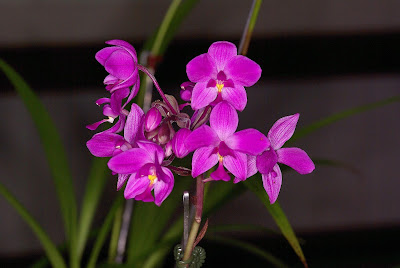Spathoglottis bulbosa is found in Malesia (New Guinea). It grows as terrestrial in lowland forest at elevation of 15 to 450 meters above sea level.
Spathoglottis bulbosa also called as The Bulbed Spathoglottis, is a species of the genus Spathoglottis. This species was described by Friedrich Richard Rudolf Schlechter in 1912.
IDENTIFY SPATHOGLOTTIS BULBOSA ORCHID PLANT
Spathoglottis bulbosa is found in Malesia (New Guinea). It grows as terrestrial in lowland forest at elevation of 15 to 450 meters above sea level.
It is a giant sized, hot growing terrestrial with a short, somewhat elongated rhizome giving rise to large to 8 cm tall pseudobulbs carrying 2 to 4, erect-patent, elliptic, acuminate, narrowing below into the long, petiolate base, 100 cm long and 12 cm wide leaves.
The Bulbed Spathoglottis blooms in the fall on a strict to substrict, glabrous, 100 cm long overall, rachis mostly glabrous, short, densely many flowered inflorescence with deflexed, oval, shortly acuminate, glabrous, shorter than the ovary floral bracts. The flowers are 5 cm in diameter, violet-pink, callus of lip yellow, lateral lobes of lip brownish red, apex of mid-lobe darker violet-pink.
SPATHOGLOTTIS BULBOSA ORCHID PLANT CARE AND CULTURE
Cultural information should only be used as a guide, and should be to be adapted to suit you. Your physical location; where you grow your plants, how much time you have to devote to their care, and many other factors, will need to be taken into account. Only then can you decide on the cultural methods that best suit you and your plants.
Light:
Spathoglottis bulbosa like indirect sunlight. 20000 - 50000 lux or speckled sunlight protected from the hottest direct sunlight of the day, 7500 lux for the youngest plants. If the plants don’t bloom, the amount of direct sunlight the plants are receiving has to increase.
Temperature:
The Bulbed Spathoglottis are generally warm growing plants liking temperatures up to the high 30˚ C and they can tolerate temperatures down into the upper 15˚ C. If the temperature in growing areas fall below 15° C for extended period, the plant may revert back to growth stage and flowering may be delayed.
Humidity:
This Spathoglottis prefer high level of humidity for better growth. Humidify the air around the plant is necessary for flowering. Misting plants daily is also effective .Grower can place a humidifier near the orchids to maintain the humidity. A pebble tray filled with water and placed underneath orchid pots also keeps air moist.
Substrate, growing media and repotting:
Spathoglottis bulbosa are very forgiving as to the potting media. You can use a media based on 75% high quality soilless mix used for hanging baskets and larger containers mixed with 25% our orchid potting media which incorporates expanded slate. Outdoor landscaping media can incorporate more orchid media for drainage - bark, perlite, sphagnum moss, and various other components. The mix is very free draining but holds more moisture than regular media for epiphytic orchids.
Repotting isn’t necessary, but potted plants should be repotted in a rich organic potting mixture once the soil has become depleted. Their root systems are fairly extensive for their size. Make sure not to damage them.
Watering:
The Bulbed Spathoglottis require good drainage in the media, so after a thorough watering allow the media to dry on top but you do not want the container to dry out altogether. Do not allow to sit in water. Water thoroughly in the morning once to twice weekly depending on your cultural conditions (light, temperature, humidity, air movement, etc.) allowing the top of the media to dry slightly between waterings. If the potting media is top-dressed with expanded slate, the area next to the pseudobulbs will dry out nice and quickly.
Fertilizer:
Spathoglottis bulbosa like fairly high feedings of fertilizer with every watering. In outdoors, use of any slow release fertilizer containing equal parts nitrogen, phosphorus and potassium and micronutrients in the 4 - 6 months release formulations gives better growth. Fertilization with diluted fertilizer (1/4 strength) every two to three weeks interval is also effective. Fertilizers with trace elements of iron and magnesium should not be used as a chemical imbalance may occur that can be harmful to the plants.















COMMENTS